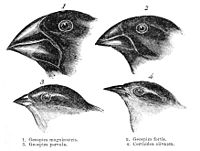
Photo from wikipedia
Investigating the relative importance of neutral versus selective processes governing the accumulation of genetic variants is a key goal in both evolutionary and conservation biology. This is particularly true in… Click to show full abstract
Investigating the relative importance of neutral versus selective processes governing the accumulation of genetic variants is a key goal in both evolutionary and conservation biology. This is particularly true in the context of small populations, where genetic drift can counteract the effect of selection. Using Brook Charr (Salvelinus fontinalis) from Québec, Canada, as a case study, we investigated the importance of demographic versus selective processes governing the accumulation of both adaptive and maladaptive mutations in closed versus open and connected populations to assess gene flow effect. This was achieved by using 14,779 high‐quality filtered SNPs genotyped among 1,416 fish representing 50 populations from three life history types: lacustrine (closed populations), riverine and anadromous (connected populations). Using the PROVEAN algorithm, we observed a considerable accumulation of putative deleterious mutations across populations. The absence of correlation between the occurrence of putatively beneficial or deleterious mutations and local recombination rate supports the hypothesis that genetic drift might be the main driver of the accumulation of such variants. However, despite a lower genetic diversity observed in lacustrine than in riverine or anadromous populations, lacustrine populations do not exhibit more deleterious mutations than the two other history types, suggesting that the negative effect of genetic drift in lacustrine populations may be mitigated by that of relaxed purifying selection. Moreover, we also identified genomic regions associated with anadromy, as well as an overrepresentation of transposable elements associated with variation in environmental variables, thus supporting the importance of transposable elements in adaptation.
Journal Title: Molecular Ecology
Year Published: 2020
Link to full text (if available)
Share on Social Media: Sign Up to like & get
recommendations!